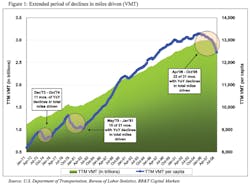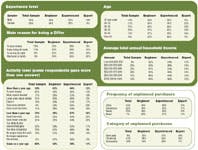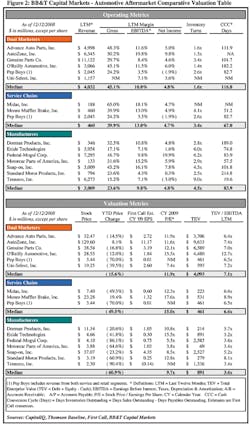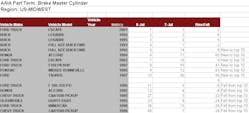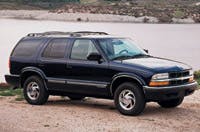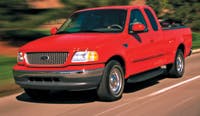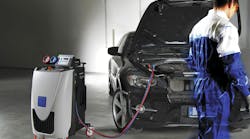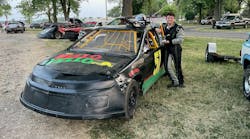PBE distributors face tough task of controlling inventory and helping shops make the transition from solvent-based paint to waterborne
Collision shops in Europe, Canada and parts of California are already making the transition because of existing or pending legislation. In California, the South Coast Air Quality Management District in Los Angeles will be the first to adopt more stringent volatile organic compound (VOC) standards for body shops. The new rules, which will take effect in July 2008, will force shops in the district to switch to waterborne products.
Jobbers will play a key role in making that conversion, but with just over a year to go, few shops have converted, and some paint manufacturers have yet to roll out their full waterborne product lines. Elsewhere in the United States, the handful of shops that have voluntarily made the change to waterborne are posing an inventory challenge to their distributors.
"We are absolutely holding extra inventory," says Larry Turow, waterborne project manager at FinishMaster Inc., a nationwide distributor with locations in 28 states. The company is assisting several shops in California with the conversion process."There is a lot of uncertainty out there, but there will be opportunities to pick up some customers," Turow adds. "When we do get that incremental business, we need to have inventory to serve those customers correctly."
Todd D'Angelo, of D'Angelo's Automotive & Industrial Coatings in California, is carrying three to six months of stock to avoid shortages as more shops start using waterborne. In some cases, he says, the paint companies are offering extended billing to help ease the transition.
"We have an advantage in that we have multiple stores to pull from," D'Angelo says. "However, jobbers with one store will have a harder time managing things."
D'Angelo operates 13 locations in California, Nevada and Arizona, six of which are affected by the new rules in California.
"There's a challenge of stocking enough paint to make sure the customer never runs out of a particular color," says Keith Brown from Auto Color Co., Inc., a Georgia-based distributor with locations in the Southeast. "The investment is pretty expensive to stock a bunch of (waterborne) paint."Auto Color previously had two customers using waterborne. One has gone back to solvent-based paints because the high turnover in their paint shop required constant re-training of new painters. The other customer has strict requirements about the age of the product, so Auto Color has to carefully manage the timing of its orders.
The sooner the better
Jobbers are encouraging shops in the affected districts in California to convert to waterborne now, rather than waiting until the last minute.
"Our desire is to get those shops that want to convert to do so as early as possible," says Turow. "This is really a capacity issue. Those shops that convert earlier rather than later will be well served by doing it. First, they want to have a decent amount of experience spraying the new type of paint. Second, by the time the legislation comes, they don't want to get in a race to the finish between July 2008 and January 2009 [when enforcement begins]."
Conversion also presents an opportunity to establish a closer working relationship with the shops. Jobbers that can assist with training and act as a knowledge source will have a leg up on the competition.
"The education process is great, because we get to spend some time with shops," says D'Angelo. "The problem is, you have to do a lot of training in a short amount of time."
"We're in the process of learning more about some of the concerns that those shops have, and adding to our strategy based on those responses to better serve those shops," says Turow.Among the issues the shops have raised have been doubts that the rest of the states will adopt the more stringent emissions standards.
"We've seen waterborne-type legislation proposed in the past and the legislators have backed off of it, so the shops are asking, 'Is this gonna happen?' " says Turow. "From our discussions with industry sources, this is absolutely going to happen."
There are also concerns about product quality, profitability and throughput, and the equipment investment that shops have to make in new guns and air moving equipment.
The cost and scope of the conversion to waterborne products will vary by customer. Depending on what kind of equipment they already have in place, shops could spend between $3,000 and $100,000 on new equipment.
New equipment shops may need to purchase could include stainless steel guns (which are resistant to rust), new types of strainers, gun washers and air movement equipment to help speed dry times for the waterborne paints."We have technical teams gearing up for shop assessments that will lead to suggested product bundles for those shops," says Turow.
In addition to helping shops assess their conversion needs, FinishMaster is putting reps on site to help answer questions and provide hands-on training after the conversion is completed.
Other companies have started offering new air movement and paint application systems targeted at the waterborne market. D'Angelo is offering a nitrogen system that heats the paint at application. That speeds the dry time without requiring any more air.
The paint manufacturers have pitched in to help with the transition in California, as well.
"The paint companies have really been stepping up to the plate," says D'Angelo. "They will pay for the machine and the toners. That takes a great burden off of jobbers."
Because there are still questions about how long it will take the rest of California to adapt to the new VOC standards, and how stringently the rules will be enforced, some shops are easing slowly into waterborne.
D'Angelo says it's better to encourage customers to take a cold-turkey approach to abandoning solvent-based paint.
"You can put a waterborne machine next to the solvent-based system, and just let the customer have some time to learn how to use the waterborne," says D'Angelo. "That doesn't really work for us. We'd rather pull the solvent out. What we've seen in some of our conversions is, when we put two machines in, they just go to the solvent system because they know it. When we do a full conversion, it goes a lot better."Collision shops in other areas might also want to take a look at converting to waterborne. Other state legislatures have been toying with stiffer VOC standards that could force the waterborne issue outside of California.
"The problem in California is that everyone has to change at the same time," says D'Angelo. "If you're in a position to do this slowly, that's much easier than what we're going to have to do.
"Don't wait for it to come to your town. Get some of your guys converted, so there's less work to do when the legislation finally does come."
Storage issues
As use of waterborne paint increases, jobbers in different areas of the country may face some storage challenges. While shops from the snowy Northeast to the balmy Gulf Coast have been using the paint without any problems, distributors (who will handle larger amounts of product for longer periods of time) will need to take some extra care in handling waterborne.
Because of the water content, this new paint reacts differently to very hot and very cold temperatures. Shelf life will also vary, depending on the brand.
"The direction that we're getting is that there is a frost problem once you get below 20 degrees Fahrenheit over an extended period of time," says Turow. "You also don't want it to get over 100 degrees or so."FinishMaster is initially rolling out waterborne through its Mira Loma, Calif., warehouse, where the temperature remains fairly constant. In warmer months, the company is monitoring warehouse temperature throughout the day.
In colder regions, distributors are storing the paint in climate-controlled areas to prevent frost. It's also advisable to keep the stock off the ground, where it might chill more quickly.
"We have to put it in a special room, and we have to watch and keep close records of when we got it in," says AutoColor's Keith Brown. "You have to make sure it goes first in, first out.
"You've got up to 24 months to use some of the products, so what they've done is reduce the size of the product down to a half-liter can. The jobber has to be very careful that he rotates his stock in and out."
"Because these are new products, we have to go by what the paint companies say rather than on our own field testing," says Turow. "In general, the shelf life issues are comparable with solvent-based paint. In some cases, that's two to three years on the lower side, and three to five years on the higher side. The good news is, the things with the shorter shelf life tend to be quick-moving products."
The clock is ticking
While most of the major paint manufacturers have released waterborne basecoat products in the U.S., "the core brand stuff is not available yet," according to FinishMaster's Turow."The big problem for us right now is that the paint companies have only released their premium lines," says D'Angelo. "We've only got 15 months left, and we've only been able to convert a few customers."
The paint suppliers will have their mid-range products out soon, but time is quickly running out.
"It's going to be a struggle," according to D'Angelo.
Once those mid-range products are available, jobbers will face a second challenge — working with smaller shops that will be reluctant to make the equipment investment needed for the conversion, and shop owners that could blanche at what will probably be higher prices for the waterborne paints.
"I'm not sure how this will go with the mid-range shops," says D'Angelo. "That's a whole different set of shops. One big concern is that the price will be higher than what they are paying right now. There will be some sticker shock."This might require some careful financial analysis. Shops will actually use less paint, since waterborne requires fewer coats. With the proper drying equipment, shops could actually increase their throughput, as well.
California jobbers also will be under pressure to make sure their customers don't run afoul of the new regulations once environmental authorities begin imposing steep fines in 2009.
"There is some lack of clarity regarding enforcement," says Craig Caudill, sales director at FinishMaster. "There is discussion at our level as to what a jobber's responsibility would be to notify the consumer or the shops if they are buying a product that's disallowed in their region. Until there is strict compliance, there will be people operating all over the map. What's the legal liability for the jobber?"That's one reason D'Angelo is encouraging shops to make a clean break from solvents as quickly as possible. "The prohibition is on possession," says D'Angelo. "As long as it's on the premises, and there are old toners still in the shop, you have to get rid of it. We're concerned that if the customer gets written up, the jobbers will get blamed for it. It's our duty as a jobber to make sure we get these guys cleaned up and aware of the rule."


